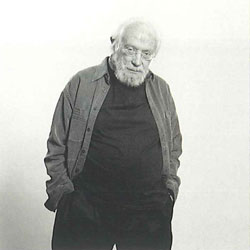Júlio Pomar
Júlio PomarLisboa ¶ 1926
 |
|
| Créditos fotográficos / Photographic credits: Abílio Leitão |
He studied at the António de Arroio undergraduate school for Decoration Arts, and the two Fine Arts Schools of Lisbon and Porto. He was an exceptional figure on the Portuguese visual arts scene in the second half of the 20th century and began as one of the pioneering advocates of the pictorial neo-realism movement. Some of the icons of his labour can be found in O Gadanheiro (The Harvester, 1945) and O Almoço do Trolha (The Bricklayer's Grub, 1946-50). From these works unto the Ciclo do Arroz (The Rice Cycle, 1952-53), Júlio Pomar developed the notion of an art engaged in political and social affairs, as well as the very image-related paths one could take with such an art, taking into account that this epoch was one of antifascism struggle. ¶ After 1957, feeling that somehow the aesthetic potential of neo-realism was depleted, and under the influence of the gesture-like dynamics of post-war European informalist painting, Pomar's career would swerve into a new direction, towards a progressive lack of distinction of the figures' outlines. It inaugurated a new relationship of tenseness between the figures and the two-dimensionality of the canvas. ¶ In 1963, Pomar moved to Paris, where he began a very plural project: he worked in "assemblages", in paintings with a strong suggestion of motion, and he also introduced in his work an abstracticizing gesture style of calligraphy. In a subsequent phase, he was to engage in more depurated formalisms, exploring well-defined, contrasting colour surfaces, traces of eroticised bodies, and the fragmentary, concealed representation of sex. ¶ The 80s witnessed yet a new phase in Pomar's work, with its gesture motions, explosions even, which create a play between the figures and their biomorphic metamorphoses. The representation of the bodies becomes important at a pictorial fiction level: one can see on Pomar's canvas figures of anthropomorphised animals set in the painting's space as elaborating an assessment of a whole cultural heritage, that is established from the traditions of the oldest narratives to the myths of a historicized Portuguese "essence". ¶ In the 90s, Júlio Pomar mainly reinvented the potential of his own painting, releasing a whole host of animal figures that mingle with the ever-present figuration of the human body, as if tempting the formal limits of its recognition.
View the embedded image gallery online at:
http://cvc.instituto-camoes.pt/biografias-en/julio-pomar-10917.html#sigFreeIdf4243bb8c1
http://cvc.instituto-camoes.pt/biografias-en/julio-pomar-10917.html#sigFreeIdf4243bb8c1


